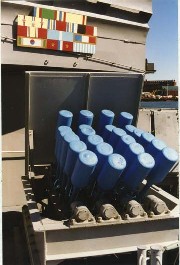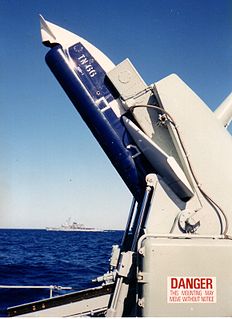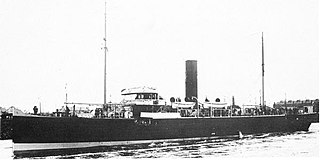 W
WAn anti-submarine weapon (ASW) is any one of a number of devices that are intended to act against a submarine and its crew, to destroy (sink) the vessel or reduce its capability as a weapon of war. In its simplest sense, an anti-submarine weapon is usually a projectile, missile or bomb that is optimized to destroy submarines.
 W
WAn anti-submarine missile is a standoff anti-submarine weapon. Often a variant of anti-ship missile designs an anti-submarine systems typically use a jet or rocket engine, to deliver: an explosive warhead aimed directly at a submarine; a depth charge, or; a homing torpedo that is carried from a launch ship, or other platform, to the vicinity of a target.
 W
WAn anti-submarine net or anti-submarine boom is a boom placed across the mouth of a harbour or a strait for protection against submarines.
 W
WA modern torpedo is an underwater ranged weapon launched above or below the water surface, self-propelled towards a target, and with an explosive warhead designed to detonate either on contact with or in proximity to the target. Historically, such a device was called an automotive, automobile, locomotive or fish torpedo; colloquially a fish. The term torpedo originally applied to a variety of devices, most of which would today be called mines. From about 1900, torpedo has been used strictly to designate a self-propelled underwater explosive device.
 W
WThe 375mm ASW rocket family is an ahead-throwing anti-submarine warfare (ASW) rocket launcher system developed by Bofors. The system has three types of launcher with either two, four or six barrels, and entered service in the 1950s. Sweden used the four-barreled system on the Hallands and Visby-class destroyers. France built the four-barrelled system under licence then developed the six-barrel system and used it on many classes of warship including T 47 and T 53-class destroyers and A 69-class avisos (corvettes). The Netherlands used it in the Friesland-class destroyers. It was also was used by Royal Malaysian Navy on the Kasturi-class corvettes before they removed it from the ships. Indonesia use it on its three Fatahillah-class corvettes and Brazil on six Niterói-class frigates, all of which are still in service.
 W
WA depth charge is an anti-submarine warfare (ASW) weapon. It is intended to destroy a submarine by being dropped into the water nearby and detonating, subjecting the target to a powerful and destructive hydraulic shock. Most depth charges use high explosive charges and a fuze set to detonate the charge, typically at a specific depth. Depth charges can be dropped by ships, patrol aircraft, and helicopters.
 W
WA naval mine is a self-contained explosive device placed in water to damage or destroy surface ships or submarines. Unlike depth charges, mines are deposited and left to wait until they are triggered by the approach of, or contact with, any vessel. Naval mines can be used offensively, to hamper enemy shipping movements or lock vessels into a harbour; or defensively, to protect friendly vessels and create "safe" zones. Mines allow the minelaying force commander to concentrate warships or defensive assets in mine-free areas giving the adversary three choices: undertake an expensive and time-consuming minesweeping effort, accept the casualties of challenging the minefield, or use the unmined waters where the greatest concentration of enemy firepower will be encountered.
 W
WA nuclear depth bomb is the nuclear equivalent of the conventional depth charge, and can be used in anti-submarine warfare for attacking submerged submarines. The Royal Navy, Soviet Navy, and United States Navy had nuclear depth bombs in their arsenals at one point.
 W
WQ-ships, also known as Q-boats, decoy vessels, special service ships, or mystery ships, were heavily armed merchant ships with concealed weaponry, designed to lure submarines into making surface attacks. This gave Q-ships the chance to open fire and sink them. The use of Q-ships contributed to the abandonment of cruiser rules restricting attacks on unarmed merchant ships and to the shift to unrestricted submarine warfare in the 20th century.
 W
WThe modern era of defending American harbors with controlled mines or submarine mines began in the post-Civil War period, and was a major part of US harbor defenses from circa 1900 to 1947.
 W
WThe UUM-44 SUBROC was a type of submarine-launched rocket deployed by the United States Navy as an anti-submarine weapon. It carried a 250 kiloton thermonuclear warhead configured as a nuclear depth bomb.